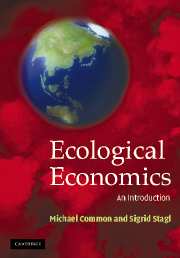Book contents
- Frontmatter
- Contents
- List of figures
- List of tables
- List of boxes
- Preface
- Introduction
- Chapter 1 An introduction to ecological economics
- PART I INTERDEPENDENT SYSTEMS
- PART II ECONOMIC ACTIVITY
- PART III GOVERNANCE
- PART IV THE INTERNATIONAL DIMENSION
- Chapter 12 A world of nation states
- Chapter 13 Climate change
- Chapter 14 Biodiversity loss
- References
- Index
Chapter 12 - A world of nation states
Published online by Cambridge University Press: 05 June 2012
- Frontmatter
- Contents
- List of figures
- List of tables
- List of boxes
- Preface
- Introduction
- Chapter 1 An introduction to ecological economics
- PART I INTERDEPENDENT SYSTEMS
- PART II ECONOMIC ACTIVITY
- PART III GOVERNANCE
- PART IV THE INTERNATIONAL DIMENSION
- Chapter 12 A world of nation states
- Chapter 13 Climate change
- Chapter 14 Biodiversity loss
- References
- Index
Summary
In this chapter you will:
Find out why international trade is generally considered beneficial to the parties involved;
Learn how national environmental and trade policies interact;
Find out in what sense globalisation reaches further than international trade;
Look at the means by which environmental policy can be implemented in the context of international trade;
Consider the advantages and disadvantages of living in a world where nations move closer together.
The nations of the world are increasingly interlinked. They are exchanging more goods and services than ever before, but they now also share transboundary and global environmental problems. In this chapter we will consider the linkages between trade and the environment, and their implications for sustainable development.
THE CASE FOR INTERNATIONAL TRADE
In this section we are going to look at the standard argument as to why trade between nations is a ‘good thing’, and to note some qualifications to that argument. We will also take a first look at the connections between trade issues and environmental issues.
The principle of comparative advantage
For thousands of years peoples have exchanged regional specialities in order to get a taste of different cultures. Trade has permitted access to goods and services unavailable otherwise. For example, Austria has produced white wine for centuries and in particular its eastern and southern regions are well suited for growing it. Iceland in turn has a clear geographic advantage for harvesting cod. Austria is a land-locked country and therefore does not have any seafish of its own.
- Type
- Chapter
- Information
- Ecological EconomicsAn Introduction, pp. 445 - 481Publisher: Cambridge University PressPrint publication year: 2005



